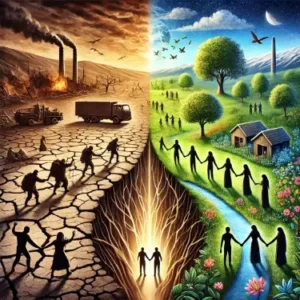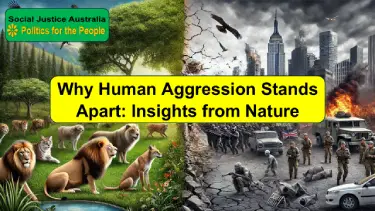Description
Explore human aggression and its distinction from animal behaviour. Learn how societal and evolutionary factors shape violence in humanity.
Introduction
Aggression is a behaviour seen across the animal kingdom, driven by survival needs such as securing territory, protecting offspring, and competing for mates. In contrast, human violence is far more complex, often stemming from ideological, psychological, or cultural factors rather than immediate survival. The scale and consequences of human aggression are uniquely devastating, shaping societies, and leaving generational scars.
This article explores the differences between animal and human aggression, emphasizing how human violence transcends instinctive survival behaviours. By addressing key examples, such as the ongoing genocide of the Palestinian people, we aim to understand the drivers of human aggression and propose solutions to mitigate its destructive impact.
Aggression in Nature and Humanity
Aggression in the Animal Kingdom: Survival-Driven Behaviours
Aggression in the animal kingdom serves functional purposes tied to survival. Whether it’s territorial disputes, dominance struggles, or competition for resources, animal aggression is situational and instinctive, often resolving conflicts with minimal harm. Examples include:
1. Territorial Conflicts
– Lions, wolves, and birds defend their territories to secure food, shelter, and breeding grounds. For example, lions may fight off rival males to protect their pride and offspring.
2. Infanticide and Siblicide
– In resource-scarce environments, species such as chimpanzees and eagles engage in behaviours like infanticide and siblicide to ensure the survival of the strongest offspring.
3. Cannibalism and Resource Scarcity
– Rodents and insects’ resort to cannibalism during extreme stress or overcrowding, reducing competition and ensuring population control.
While these behaviours may appear brutal, they are rooted in evolutionary needs and typically lack the intentionality and ideological justifications seen in human violence.
Human Aggression: Beyond Survival
Human aggression, unlike animal aggression, often arises from abstract motivations, such as ideology, power, or resource control. This has led to conflicts with far-reaching and catastrophic consequences.
1. Genocides
– Genocide is the deliberate and systematic extermination of a group of people, often motivated by ethnic, religious, or political differences. The human ability for genocide is unparalleled in the natural world and is among the most devastating expressions of aggression.
Historical Examples:
– The Holocaust: Six million Jews were systematically murdered during World War II, driven by the Nazi ideology of racial purity.
– The Rwandan Genocide: In 1994, over 800,000 Tutsi were killed in a span of 100 days, fuelled by ethnic tensions and political propaganda.
Ongoing Example – The Palestinian Genocide:
– The plight of the Palestinian people reflects an ongoing genocide marked by systematic displacement, destruction of homes, and suppression of rights.
– Land Displacement: Over decades, Palestinian territories have been reduced through illegal settlements and annexations.
– Violence and Suppression: Airstrikes, blockades, and military interventions disproportionately target civilian populations, with thousands killed and injured, including children.
– Global Indifference: Despite international outcry, many governments are still complicit or silent, driven by geopolitical alliances and economic interests.
Genocides, whether historical or ongoing, exemplify the scale and intentionality of human aggression. Unlike animal conflicts, these acts are sustained over time and justified through ideology, fear, and the dehumanization of others.
2. Complex Motivations for Human Violence
– Economic Control: Wars and genocides often have underlying economic motives, such as resource control. For example, the conflict over Palestinian land is intricately tied to geopolitical power and access to resources in the region.
– Psychological and Ideological Factors: Human aggression is amplified by fear, hatred, and dehumanization, perpetuated by propaganda and systemic inequality.
3. Long-Term Impact
– Genocides and large-scale violence leave scars that persist for generations, manifesting as trauma, economic disparity, and continued cycles of aggression.
Australia’s Aggression Against Indigenous Peoples
Australia’s history is marked by systemic aggression against its Indigenous peoples, including acts of dispossession, violence, and cultural erasure. From the moment of colonization in 1788, Aboriginal and Torres Strait Islander communities faced widespread displacement as settlers seized their lands without treaties or compensation.
This aggression was not limited to territorial conquest but extended to policies designed to destroy Indigenous cultures and autonomy.
1. Dispossession and Violence:
– Frontier conflicts during the 18th and 19th centuries saw the mass killing of Indigenous Australians, often justified by racist ideologies that framed them as inferior or obstacles to progress. Estimates suggest tens of thousands were killed in these violent encounters.
2. Stolen Generations:
– From the late 19th to the mid-20th century, government policies forcibly removed Aboriginal children from their families to assimilate them into white society. These policies caused deep intergenerational trauma, severing cultural ties, and inflicting psychological harm on countless Indigenous families.
3. Systemic Oppression:
– Indigenous Australians continue to face systemic inequalities, including higher rates of incarceration, poorer health outcomes, and restricted access to education and employment opportunities. These issues are legacies of past aggression and ongoing neglect.
This aggression against Indigenous peoples is not merely a historical issue but an ongoing challenge that demands reconciliation, justice, and systemic reform to address the long-standing harm inflicted on Australia’s First Nations.
What Makes Human Aggression Unique?
1. Premeditation and Long-Term Planning
Human aggression is unique in its ability for premeditation and strategy. Wars, genocides, and systemic oppression often involve months or years of planning.
• Example: The ongoing occupation of Palestinian territories is not a spontaneous conflict but a carefully orchestrated campaign involving political policies, military actions, and economic restrictions.
2. Ideological Justifications
Humans use ideologies to rationalize violence, often dehumanizing their victims to justify aggression. This is clear in:
• Religious Extremism: The Crusades and modern conflicts have been framed as divine mandates.
• Nationalism and Racism: Genocides, including the persecution of Palestinians, are often justified through nationalistic or ethnocentric rhetoric.
In the case of Palestine:
• Media Narratives: Mainstream narratives often frame Palestinians as aggressors, obscuring the realities of their oppression.
• Global Politics: Nations prioritize alliances over justice, enabling ongoing violence.
3. Scale and Intergenerational Consequences
Human aggression creates ripple effects that last for decades:
• Trauma: Generations of Palestinians have grown up under siege, seeing violence and losing homes and family members.
• Global Instability: Conflicts such as the Israeli Palestinian struggle fuel regional and global tensions, affecting economies and political alliances.
The persistence of these conflicts highlights the uniquely destructive nature of human aggression.
Lessons from Nature and Human Society
To address human aggression, particularly acts of genocide like that against the Palestinian people, a multifaceted approach is needed:
1. Learning from Nature
While animals show aggression, they also employ strategies to minimize harm and promote coexistence:
• Social Bonds: Species like bonobos resolve conflicts through social bonding rather than violence, a model for fostering empathy and cooperation.
• Clear Boundaries: Territorial animals often avoid direct confrontation by respecting boundaries, a principle that could inform peaceful resolutions in territorial disputes like those in Palestine.
2. Addressing Root Causes of Human Aggression
1. Global Solidarity:
– Support grassroots movements that amplify the voices of oppressed communities, such as Palestinians, ensuring their stories are heard on a global stage.
– Demand accountability from governments and international organizations complicit in acts of aggression.
2. Empowering Victims:
– Invest in rebuilding communities affected by aggression, offering resources for education, healthcare, and mental health support.
– Provide platforms for displaced populations to advocate for their rights.
3. Economic and Political Reform:
– Cut funding to oppressive regimes and redirect resources toward humanitarian efforts.
– Promote fair policies that address the economic roots of conflict.
4. Fostering a Culture of Peace
1. Educational Initiatives:
– Teach the history of genocides and conflicts, including the plight of Palestinians, to promote understanding and prevent dehumanization.
– Encourage critical thinking to counter propaganda and misinformation.
2. Media Responsibility:
– Advocate for unbiased reporting that highlights the realities of conflicts like the Israeli Palestinian struggle.
5. Using Technology for Advocacy and Peace
– Use technology to document and share evidence of human rights abuses in conflict zones, amplifying calls for justice.
– Develop platforms that connect activists, fostering global collaboration for peace.
Building a More Compassionate World

Human aggression, particularly acts of genocide, underscores the destructive potential of ideological and systemic violence. By addressing its root causes and fostering empathy, humanity can move toward a more peaceful future.
Question for Readers:
How can global citizens hold governments accountable for ongoing acts of aggression, such as the oppression of Palestinians?
Call to Action
If you found this article insightful, explore more about political reform and Australia’s monetary sovereignty on Social Justice in Australia: https://socialjusticeaustralia.com.au/.
Share this article with your community to help drive the conversation toward a more just and equal society.
Click on our “Reader Feedback” menu. Let us know how our content has inspired you. Submit your testimonial and help shape the conversation today!

